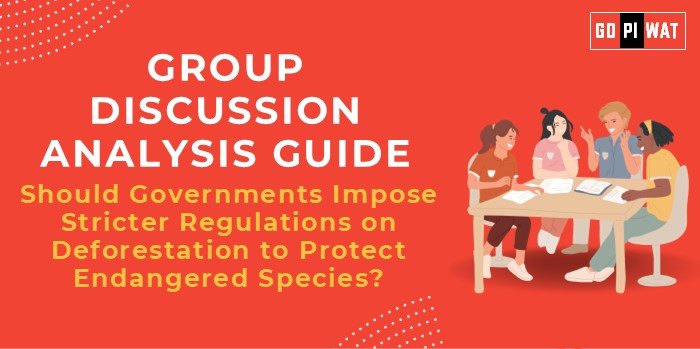🌳 Group Discussion (GD) Analysis Guide: Should Governments Impose Stricter Regulations on Deforestation to Protect Endangered Species?
🌐 Introduction to the Topic
Opening Context: “Forests, often called the lungs of the Earth, are critical for biodiversity and climate balance. However, deforestation threatens numerous species and disrupts ecological systems.”
Topic Background: Deforestation is responsible for nearly 20% of greenhouse gas emissions globally and endangers over 28,000 species. Stricter regulations could mitigate these threats while addressing climate goals.
📊 Quick Facts and Key Statistics
- Deforestation Rate: Over 10 million hectares of forests are lost annually (FAO, 2023), directly impacting endangered species.
- Biodiversity Loss: 75% of terrestrial biodiversity resides in forests, which are under increasing threat.
- Economic Cost: Illegal logging and deforestation cost the global economy $10 billion annually.
- Protected Species: Nearly 25% of global mammal species are threatened due to habitat destruction.
🤝 Stakeholders and Their Roles
- Governments: Enforce laws, monitor deforestation, and manage protected areas.
- Environmental NGOs: Advocate for policies, raise awareness, and support reforestation projects.
- Local Communities: Depend on forests for livelihoods; involvement is crucial for sustainable management.
- Businesses: Logging, agriculture, and mining companies are significant contributors to deforestation.
✅ Achievements and Challenges
🌟 Achievements:
- Amazon Fund: Preserved 60 million hectares of forest (2023).
- India’s Compensatory Afforestation Program: Planted 1.5 billion trees in five years.
- Costa Rica’s PES Program: Increased forest cover to 52% of total land area.
⚠️ Challenges:
- Weak law enforcement leads to illegal logging.
- Conflicting interests between development and conservation.
- Insufficient funding for large-scale reforestation.
🌍 Global Comparisons:
- Success: Norway’s zero-deforestation policies.
- Challenges: Indonesia’s deforestation crisis due to palm oil plantations.
📖 Case Studies:
- Brazil’s Success: Reduced Amazon deforestation by 83% from 2004-2012 (prior to 2020 reversals).
🛠️ Structured Arguments for Discussion
- Supporting Stance: “Stricter regulations are essential to ensure the survival of endangered species and achieve global climate targets.”
- Opposing Stance: “Regulations may negatively impact local economies and create implementation challenges in developing regions.”
- Balanced Perspective: “While regulations are necessary, integrating local communities and sustainable practices ensures long-term success.”
🎯 Effective Discussion Approaches
- Opening Approaches:
- Begin with startling data: “Every year, over 10 million hectares of forest vanish—home to endangered species like orangutans and tigers.”
- Highlight global responsibility: “The biodiversity crisis is a shared global concern that transcends borders.”
- Counter-Argument Handling:
- Offer alternatives, like sustainable agroforestry.
- Reference successful global models, such as Costa Rica.
📋 Strategic Analysis of Strengths and Weaknesses
- Strengths: Enhanced species survival, climate resilience, and biodiversity.
- Weaknesses: Economic dependency on forest resources, enforcement issues.
- Opportunities: Carbon credits, ecotourism, and sustainable industries.
- Threats: Corruption, global demand for timber, and population pressure.
💼 Connecting with B-School Applications
- Real-World Applications: Impact analysis for sustainability projects and CSR initiatives.
- Sample Interview Questions:
- “How can stricter regulations balance conservation and economic needs?”
- “What role can businesses play in reducing deforestation?”
- Insights for Students:
- Analyze global best practices for sustainable management.
- Leverage policy-making knowledge for business strategies.


